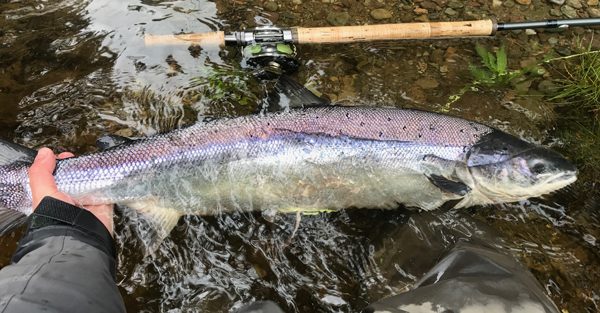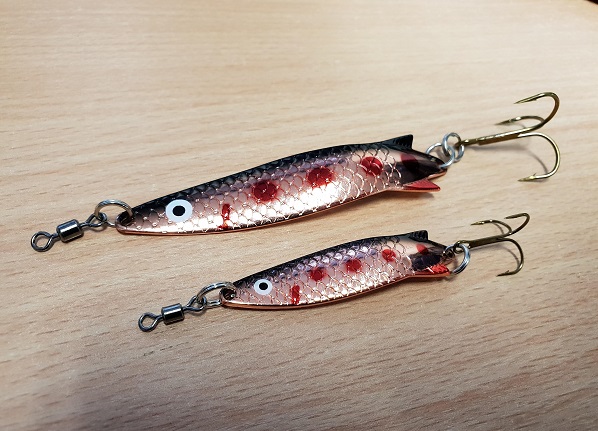It is said that a salmon will move a long way for a fly, if the conditions are right. With your hands, count how many times you’ve had the “right” conditions this season?
So you’ve got the rod, reel and line all balanced. You’ve got a selection of sink tips, nylon/fluoro and an enormous selection of different types of flies. You’re happy and actually quite confident you’re covering the pools nicely with your casting, but still you feel that your salmon fishing should be rewarding you better. The answer could be simple and costs you nothing more than the small fortune you’ve already invested in.
Placement
As an introduction, let’s get practical here and try to understand why our fly fishing shelves in-store here are packed full of choices. As always, it’s nice to have options, and so there are choices of many types of fly lines, running lines, tips and flies, and everything else available to the angler for so many different reasons. Every item has a different purpose, yet every item has a common goal. To simplify it right down – fishing is all about “placement”. Regardless of what you buy or where you go, when you go and why you go, every single decision you make (conscious or sub-conscious) is ultimately about the placement of your fly. Many forget though that all the equipment in the world won’t buy you successful fishing if you don’t “think like a fish”.
Fine dining
If you were sitting in a nice restaurant and the dessert you had ordered was served to another table (a) you probably wouldn’t notice, and (b) if you did notice, would you go over to that table and take it off them? No. So, imagine now you’re a salmon sitting in your favourite lie in a pool. A gorgeous fly passes way over your head and not in front of you, (a) you might not have noticed it, and (b) would you go to get it when it’s a good bit of effort and you just want to relax and be comfortable? No.
The argument that comes out of this is whether salmon take a fly out of feeding habit or if it is actually just annoying them, probably both but who knows? Habit – if a yummy dessert was placed right in front of you, the chances are you’ll eat it. It is the same with a salmon, get the fly right in front of it and the chances are, it’ll eat it.
Raising your presentations to new depths
So that’s the why, here’s the how. The key to placing the fly right in front of a deeper lying salmon is slack line. Now some of you reading this will say that’s a single handed method, or, there’s no point in a fly landing, to not fish until mid way through a swing, well, yes there is in many circumstances. Times when you need to fish deep are most of the early Spring when the fish are deep and lethargic in the cold water, and then there are the mid-Summer to back-end fish that are territorial and have won the deepest lies.
Here are four ways to add slack to your salmon fly line, allowing the fly to get down into the face of the salmon. These methods cost you nothing and could make your fishing so much more rewarding:
1 – Cast Then Step
The easiest method. Traditionally, you will have been taught to move downstream once the fly has come around and you have retrieved ready for the next cast. With the ‘cast then step’ method you make your cast as usual, then move 2-3ft downstream, allowing your fly, sink tip, or sinking line more time to sink before it straightens in the current and starts to fish. In faster water this will require a squarer cast allowing more sinking time. Factor in a good upstream mend to slow the swing down. On the dangle, retrieve the line and cast again, then move.
2 – Steeple mend
This is one of the most effective methods to sink a heavy fly really deep, great for fast runs. Once your line has landed straight after a cast, lift the tip of the rod up to nearly 12 o’clock and then drop it down again whilst pointing at the fly. This has introduced around 6-10ft of slack into your presentation. The real beauty of this method is there are no hanks of line to tangle up the fly because the line is constantly straight. You can even compliment this mend by swinging it upstream as you lift and drop to slow the swing.
3 – Pile, Wiggle & Tuck Casts
Well known as single handed techniques, these styles of casts allow slack into the line “before” it lands on the water. Pile casts are driven high into the air at nearly 30-40 degrees above the surface simply by aiming higher on your forward stroke (try aiming at the tops of the trees). The line will fall slowly down in a less than straight way from the rod tip down to the fly landing last. The pile cast is great for slower more spooky pools as the line lands gently, not great for heavy flies, but with a sink tip this is an excellent option.
The wiggle cast is exactly as it sounds, wiggle the rod tip from side to side vigorously after your forward stroke while the line is airborne and the running line will land in a zigzag pattern. It will take a good length of time to straighten. This cast is great for faster currents or when you are fishing over a boil. The wiggle cast does not work for mono shooting lines, only coated running lines or integrated lines.
The tuck cast – By seriously over-powering your forward stroke and including a very aggressive and premature ‘stop’ by grabbing the running line as it shoots through the eyes or pulling back on the tip of the rod just before the line straightens in the air, this will cause the line to overpower and tuck underneath, thus adding slack line to the tip of the line – a brilliant cast for fishing a deep eye on the far side of faster water whilst holding the rod tip high over the rapids. It is easiest to try this with a skagit line because of the amount of energy you can release with a heavier head. As a visual example, if you have ever cast a skagit line without a tip on the front this overpowering is maximised and you’ll see the end of the line underneath as it stops.
4 – The Spaghetti Cast
Lastly, the most technical of all methods here, is the ‘Spaghetti cast’. Okay, we’ve no idea what others will call it besides a mess, but if you can perfect a cast that shoots out the distance you need, long or short, but then fails to straighten at the tip and it lands in a heap (excuse the technical terms), you have it made! So many times, experienced anglers witness fish being caught on the worst cast by the most novice of anglers. This is because they made a cast about an hour ago, the fly has bumped along the bottom, the novice is oblivious to any adjustments that most anglers would make, the line finally straightens, and the fish sees this lovely morsel come to life right in front of their nose – Bon appetite.







